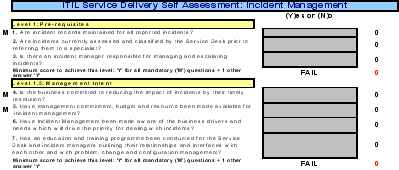ITIL Implementation - ITIL Assessment
| diese Seite auf Deutsch |
|---|
Step 4: Analysis of As-Is Processes: ITIL Assessment
An analysis of the current situation should precede any process reorganisation; this will make it possible to decide which current processes may be left unchanged and where, on the other hand, there is an especially urgent need for action.
Often, the as-is analysis takes the form of painstakingly documenting current processes in great detail.
This effort does not usually justify the means, as an as-is survey is focusing on the past. However, a fixation upon the current, often outdated procedures tends to obstruct one's sight when redesigning processes in a simpler, more effective way. Instead, it is recommended to evaluate the current processes using a set of objective criteria, thereby identifying weaknesses and opportunities without a very time-consuming effort for process documentation. The method of ITIL Self Assessment is ideal for this task.
Objective of this Project Step
- Determination of weaknesses and opportunities within current processes
Prerequisites
- (the catalogue for self assessment is on offer from itSMF on the Internet)

Results/ Deliverables
- Rating of the IT organisation within the individual ITIL disciplines
- List of weaknesses and opportunities with respect to the ITIL principles (these are to be eliminated during the ITIL project)
Description
An ITIL assessment is by all means also recommendable if ITIL is to be introduced for the first time. As ITIL has grown out of practical experience, there will almost certainly be areas in which ITIL principles are being observed today – indications therefore, that some of the current processes should continue to be used in the future.
Members of IT Management as well as employees from the functional level are chosen as interview partners for the assessment. The interviewer guides the respondents through the questionnaire, helping with explanations of the background behind specific questions if required.
The subsequent evaluation highlights
- the maturity levels achieved within the individual ITIL disciplines
- important deviations in the judgement of process quality by individual interview partners
- identified weaknesses in the current processes and their underlying causes, as well as opportunities
Success Factors
The analysis should cover all the main areas of the IT organisation; for this purpose it is a necessity that the majority of IT Management staff as well as a representative selection of functional employees participate in the survey.
The interviewer should already be familiar with the ITIL principles, in order to be in a position to answer the interview partners' questions.






